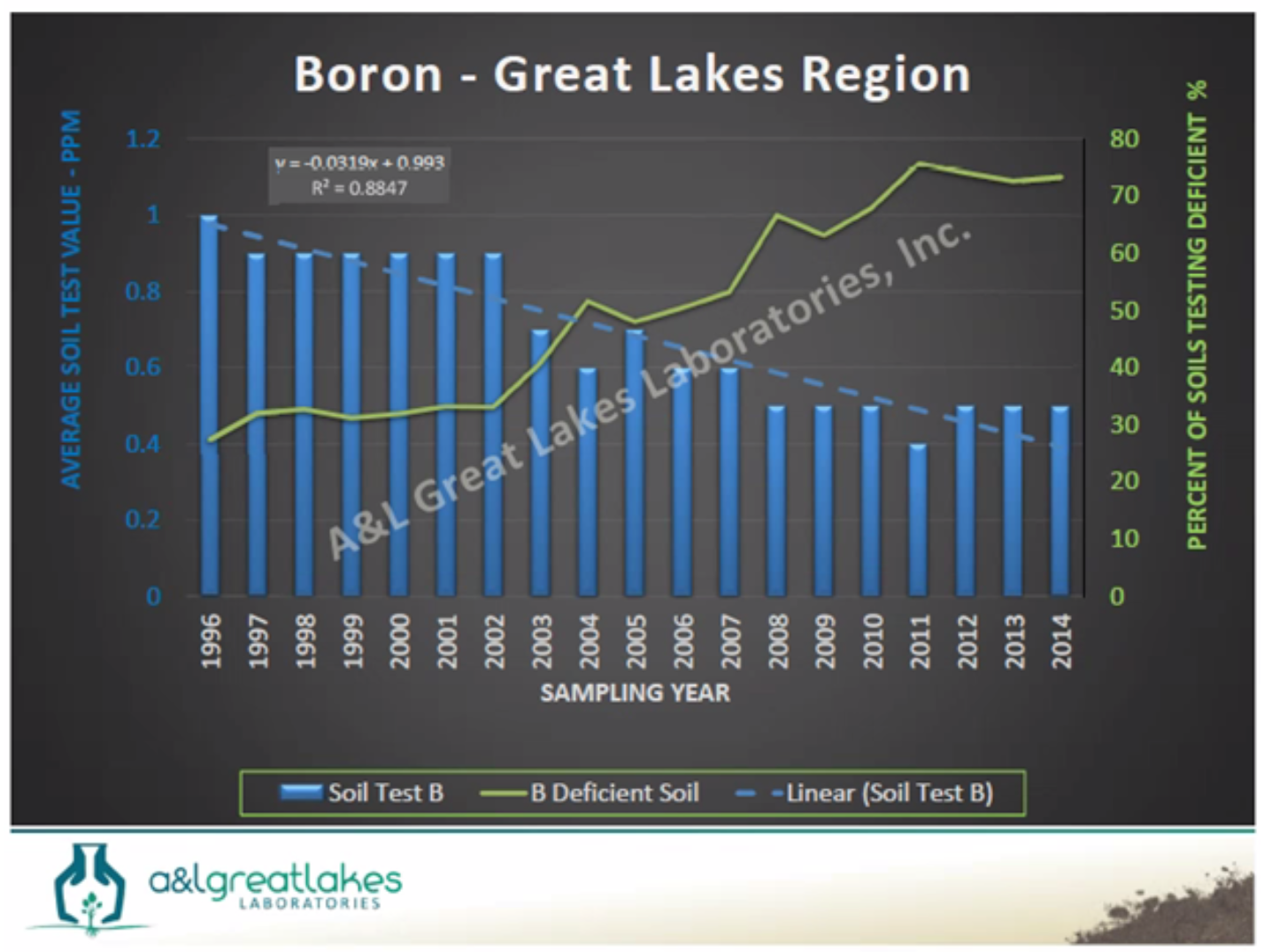Update from the Field: Small Quantities, Giant Rewards Part 2
Posted by Dave Dyson, Agronomist on February 12, 2019
This post may reference products and/or services only available to our Retail Farm Center customers. For more information contact your Territory Manager at The Andersons.

This is the second article in a four part series outlining the reasons why micronutrients may be used in small quantities, yet deliver giant rewards.
Boron, one of the micronutrients that is essential for crop health, also happens to be one of the most deficient micronutrients in the majority of fields. According to A&L Great Lakes Laboratories, 94.1% of all agriculture soil samples that they processed in 2018 show boron test results that are below 1.2ppm. When applying boron, growers will likely see positive returns until the soil test reaches 2ppm. Based on A&L’s data, over 95% of all fields would show a positive result from applying an application of boron. Figure 1 shows a decrease of boron in the soil over time. It also shows an increase in the percentage of soil samples that are deficient in boron.

Figure 1: This chart shows the decline in boron amounts over time in soil samples submitted to A&L Great Lakes Laboratories.
One of boron’s main roles in the plant’s physiology is forming and strengthening cell walls. The concentration of boron is different among species. Dicots (soybeans and alfalfa) require higher levels than monocots (corn and wheat), and therefore, they demand higher boron levels. Boron is very instrumental in root and pollen tube elongation.
Boron deficiencies can result in short and thick cell walls that can inhibit both root uptake and reproduction. Flowers can fail to set seeds, and research also shows that boron is important in nitrogen fixation and nodulation in legumes. Plants deficient in boron have a decreased rate of water absorption and translocation of sugars in plants. While boron is an important nutrient on its own, it also has a positive impact on the uptake of potassium and phosphorus in many plants. The uptake of potassium and phosphorus can be severely reduced under low boron conditions.
Field crops like corn, soybeans, and wheat cannot remobilize boron in the plant, so you must deliver a good supply throughout the growing season. To compound this problem, the range between deficient and toxic availability is very narrow. Spoon-feeding this micronutrient throughout the season is the best course of action. My recommendation is to start out with 1qt/ac of MicroCarb ZMB™ in your high-ortho, in-furrow fertilizer. This amount of boron will give your crop a nice kick to get started. Next, we need to come back in with 1 qt/ac of Eezy™ Moly-B during VT in corn, R1-R3 in soybeans, or flowering in wheat, to continue the uninterrupted supply of boron to the plant during the reproductive stage.
In conclusion, boron is a very important micronutrient, although needed by the crop in very small amounts. I would encourage all producers to include boron in their fertility program. The Andersons has a multitude of boron products available, so please reach out to me or one of The Andersons’ Ag Advisors if you have any questions on which product to use and when to use it.
FOR MORE INFORMATION:
Please complete the form, and we’ll get you in touch with your Territory Manager from The Andersons.

Dave Dyson is a regional agronomist for The Andersons’ Farm Centers which are located throughout Ohio, Michigan, and Indiana. He is an Indiana native and grew up on a dairy farm in Miami County. A graduate of Purdue University with a degree in Crop & Soil Science, Dave has a deep knowledge of various agronomic topics and is committed to helping growers improve their crops. If you have any questions, Dave can be reached at david_dyson@andersonsinc.com.
Eezy, and MicroCarb ZMB are trademarks of The Andersons, Inc.


